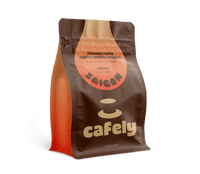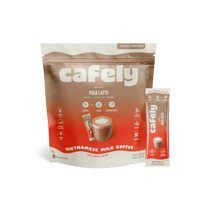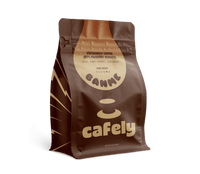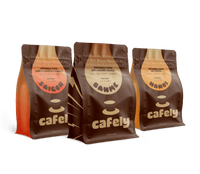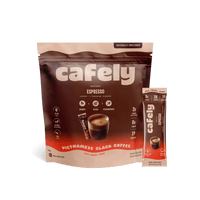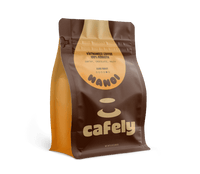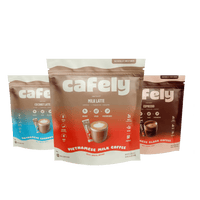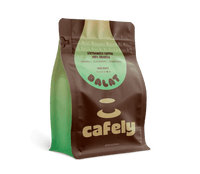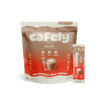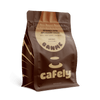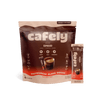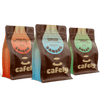So you’ve heard coffee is naturally acidic, and that’s why your stomach might ache after your third cup without food. But how acidic is it, and what does that mean for your body?
This article will explain the role that acid plays in taste, the health impacts associated with acid, and what makes a cup of coffee acidic.
How Acidic Is Coffee?
Acidity is measured with the pH scale, which ranges from 0 pH to 14 pH.
Here's a breakdown of the pH Scale:
- 0-6 Acidic — The lower the pH, the higher the acid level. For example, citrus juices and vinegar have pH levels around two to three, and battery acid has a pH level of zero.
- 7 Neutral — Pure water has a neutral pH of seven.
- 8-14 Basic — The higher the pH, the lower the acid level. These foods or substances are alkaline. An egg has a pH of eight, while root vegetables and many nuts and seeds have a pH of nine to ten. Soaps and cleaning solutions, including bleach, have a pH of 12 to 14.
The acidity of coffee can vary depending on the type of coffee bean, the quality of the coffee bean, and the brewing method. However, most brews have a pH level of 4.85 to 5.13 [1].
Though this means coffee is acidic, acid is not inherently bad. Plenty of healthy foods fall into the acidic category. However, a substance too far from neutral (pH 7) becomes inedible — whether it’s too acidic or too alkaline. Some people with sensitive stomachs or other health concerns might prefer coffee with less acid.
Factors Affecting Coffee’s Acidity

Several factors impact the level of acid in a cup of coffee. It all starts with the type of coffee beans, but the roast level and brewing method also play a role in the pH of your cup of joe.
1. Arabica vs. Robusta Coffee Beans
Coffee is made with either arabica beans, robusta beans, or sometimes a combination of the two. Vietnamese coffee is usually made with 100% robusta, which is less acidic than arabica coffee beans. Robusta coffee beans have a pH level of 5.25 to 5.4, while arabica coffee beans have a pH level of 4.85 to 5.15 [2].
2. Roast Level
The roast level of coffee beans is one determining factor of acidity. Longer roast times allow more time to break down the acids in coffee, so dark roast coffee tends to be less acidic than light or blonde roast coffee [3].
3. Brewing Methods
Coffee beans have several types of acids, and the brew method and water temperature can alter these acid levels. A change in this acid composition can change a cup of coffee's pH level and taste.
Here are some ways that the brew method can impact the acidity of coffee:
- Water Temperature — Brewing methods that use boiling water, like the percolator, result in the lowest pH or highest acidity levels, though the high temperature may burn the coffee.
- Cold Brew — Cold brew contains less acid and has a higher pH level than coffee brewed with warm or hot water.
- Equipment — Brewing equipment can impact the acidity of a cup of coffee. Turkish coffee and coffee made with a moka pot produce the most acidic cups of coffee, followed by drip coffee and pour-over.
- Equipment Material — Brewing equipment made of glass produces the least acidic cups of coffee. These include the Chemex (glass pour-over), the cold drip brewer, and the French press [4].
Health Implications of Coffee Acidity
Coffee acidity not only impacts taste, but it can also impact health.
Here are some potential health impacts of acidic drinks:
- Irritable Bowel Syndrome (IBS) — Both coffee and caffeine are associated with greater odds of IBS symptoms [5].
- Acid Reflux — (Also known as oesophageal reflux, GER, or GERD). Study results conflict with the relationship between acid reflux and coffee, yet many individuals claim coffee causes an increase in their symptoms [6,7].
- Heartburn — Much like acid reflux, studies do not definitively support or deny a connection between coffee and heartburn, but many people report experiencing heartburn after drinking coffee [8].
- Dental Concerns — The pH of coffee can directly impact dental health and even impact babies' enamel in vitro [9].
Adjusting the Acidity of Your Coffee

Although some of the processing steps that change the acidity of coffee are out of your hands, there are still ways to reduce coffee’s acidity levels at home.
Here are some ways to increase the pH of your cup of joe.
- Choose dark roast coffee beans — Choose dark roast coffee beans to reduce the acidity levels in your cup of coffee [3]. Light and medium roast coffee beans tend to have higher acidity levels.
- Choose a brew method using glass or ceramic equipment — Brewing methods that use stainless steel equipment result in the highest acidity levels of coffee [4].
- Lower the brew temperature — A lower brewing temperature will also help reduce the acidity level of coffee [11].
- Brew time — Longer brew times are linked with lower acidity levels in coffee. For example, cold brew takes a long time to brew and is one of the least acidic types of coffee [11]
- Add milk — Because milk and cream are less acidic than coffee, adding milk or cream to coffee will lower the acidity of your cup of coffee.
FAQs: Coffee Acidity
Do you still have questions about coffee acidity? Let’s answer the most common ones below.
1. What Is the Typical PH Level of Coffee?
The acidity of coffee can range from a pH of 4.85 to 5.4, depending on the style of coffee bean, brew method and equipment used, and the water temperature during brewing [2,12].
2. How Can I Make My Coffee Less Acidic?
To make your cup of coffee less acidic, you can try any of the following:
- Darker Roast — Use darker roast coffee beans, as lighter roasts are more acidic [3].
- Cold Brew — Cold brew or even just cooler water while brewing will lead to less acidic coffee [4].
- Add Milk — Milk has a higher pH than coffee, so mixing the two lowers the overall acidity in your cup of coffee.
3. Is Coffee Acidity Bad for Health?
Coffee is not generally considered unhealthy, though if you have certain health conditions, it may make them worse. If you’re experiencing stomach pain, heartburn, or frequent trips to the bathroom after coffee, talk to your doctor to clear things up.
4. Does the Type of Coffee Bean Affect Acidity?
Yes, robusta coffee beans are less acidic than arabica beans. Robusta beans tend to have a pH of around 5.25 to 5.4, while typical arabica beans have a pH of 4.85 to 5.15 [2].
5. Can Adjusting Brewing Time Affect Coffee’s Acidity?
Yes, longer brew times can result in a less acidic cup of coffee. This is true with cold brew coffees that brew for longer than hot coffee [12].
6. What Are the Best Low-Acid Coffee Options?

The best low-acid coffee options include Vietnamese coffee, coffees made with dark roast coffee beans, and cold brew coffee [2,3,4]. Look for dark roasted beans and consider cold brew options.
7. How Does Roasting Affect Coffee Acidity?
Light roast coffee has higher acidity because the acids don’t cook out [13].
8. Are There Any Coffee Additives That Reduce Acidity?
The most common way to reduce acidity in coffee is to add milk. Milk has lower acidity than coffee, so mixing the two will lead to a less acidic beverage.
9. Is It Possible to Measure Coffee Acidity at Home?
Yes, you can test the pH of your coffee at home with pH strips or with a digital pH reader.
10. Why Is Robusta Coffee More Acidic Than Arabica?
Robusta coffee tastes more bitter than arabica and has higher concentrations of specific acids, but robusta coffee is overall less acidic than arabica coffee [14].
References
- Rao, N. Z., & Fuller, M. (2018). Acidity and Antioxidant Activity of Cold Brew Coffee. Scientific reports, 8(1), 16030.
- Darmayanti, S., Harahap, N. Z., Natassa, S. E., & Yanti, G. N. (2024). The Influence of Arabica and Robusta Coffee Consumption on the Flow Rate, Viscosity, and pH of Saliva among Students at the Faculty of Dentistry, Universitas Sumatera Utara. Journal of International Dental and Medical Research, 17(4), 1401-1407.
- Habara, M., & Horiguchi, T. (2024). Impact of Coffee Roasting and Grind Size on Acidity and Bitterness: Sensory Evaluation Using Electronic Tongue. Chemosensors, 12(9), 196.
- Alessandroni, L., Angeloni, S., Caprioli G., Fioretti, L., Ricciutelli, M., Santanatoglia, A., & et al. (2024). Comprehensive investigation of coffee acidity on eight different brewing methods through chemical analyses, sensory evaluation and statistical elaboration. Food Chemistry, 454, 139717.
- Adibi, P., Esmaillzadeh, A., Keshteli, A.H., Koochakpoor G., & Salari-Moghaddam A., (2021). Association of Coffee and Caffeine Intake With Irritable Bowel Syndrome in Adults. Front. Nutr. 8, 632469.
- Kim, J., Kwon, C., Lee, H., Lee, H.K., Myung,S.-K., Oh, S.-W. (2014). Association between coffee intake and gastroesophageal reflux disease: a meta-analysis. Diseases of the Esophagus, 27(4), 311–317.
- Hartoyo, F., Sidharta, V. K. Tandarto, Tenggara, R. (2022). The Correlation Between Coffee Consumption and Gastroesophageal Reflux Disease. The Indonesian Journal Of Gastroenterology Hepatology And Digestive Endoscopy, 23(1).
- DiBaise, J.K. (2003). A Randomized, Double-Blind Comparison of Two Different Coffee-Roasting Processes on Development of Heartburn and Dyspepsia in Coffee-Sensitive Individuals. Dig. Dis. Sci., 48, 652–656.
- Alangari. S.S., Albaqami, N.N., Ali, R., Alkhneen, S.M.S., Almogble, E.A., et al. (2022). Evaluation of Titratable Acidity and pH Level of Different Coffee Drinks- An In-vitro Study. PJMHS 16(1), 767-770.
- Biju, D., Davis, I.M., Fong, L.E., Forester, S.C. Kaur, B., Mojica, B.E., & et al. (2018). The Impact of the Roast Levels of Coffee Extracts on their Potential Anticancer Activities. Journal of Food Science, 83, 1125-1130.
- Cordoba, N., Pataquiva, L., Osorio, C. & et al. (2019). Sci Rep 9, 8440.
- Rao, N.Z., Fuller, M. (2018). Acidity and Antioxidant Activity of Cold Brew Coffee. Sci Rep 8, 16030.
- Birke Rune, C.J., Duelund, L., Giacalone, D., Mathias Porsmose Clausen, M., Münchow, M., Steen, I. (2023). Acids in brewed coffees: Chemical composition and sensory threshold. Current Research in Food Science, 6, 100485.
- Bicho, N.C., Leitã, A.E., Lidon, F.C., Ramalho, J.C. (2013). Quality assessment of Arabica and Robusta green and roasted coffees – A review. Emir. J. Food Agric., 25(12), 945-950.
